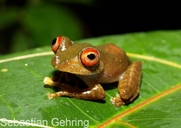|
Description
A small brown treefrog. Males 25-30 mm, females larger (estimated size
of one female 35 mm). Back brown often with more or less distinct transverse
bars and numerous, very small, dispersed black spots. Flanks with numerous white spots, but without marks underneath tympanum or eye. Slightly developed white lateral folds along arm and tarsus. Skin on the back smooth. Venter creamish. Iris brown around the pupil, surrounded by red on the outer iris area. Iris periphery is blue. Nostrils are equidistant between the eye and tip of snout. Tympanum/eye ratio about 1/2. Tibiotarsal articulation reaches between nostril and tip of snout when hind limb is brought forward. Small dermal flaps or tubercles on the heel and elbow.
Webbing of the hand:
a trace of webbing between 1 and 2i and 2e and 3i, 3e(1.5), 4(1); webbing of
the foot 1(0.75), 2i(1), 2e(0.5), 3i(1.5), 3e(0.5), 4i/e(1.5), 5(0.5). Males
with nuptial pads and a slightly distensible, single subgular vocal sac.
Specimens from Andringitra have a similar call but differ
by a network of elevated ridges on the back, distinct black tubercles on the
legs and a distinct white spot between eye and upper lip.
Similar species:
All juveniles of the Boophis goudoti-group; B.
reticulatus, B. burgeri and B.
sp. b are bigger
(see Glaw and Vences 1992).
Distribution and Habitat
Country distribution from AmphibiaWeb's database: Madagascar
Ambohitantely, An’Ala, Andasibe, Ankeniheny. Exist at elevations in eastern Madagascar around 400-1,000m and in Ambohitantely around 1,500m. This species lives in rainforest and breeds in nearby streams (Nussbaum et al. 2008).Life History, Abundance, Activity, and Special Behaviors
Males call at night 1-2 m high from vegetation along brooks in primary forest. A pair was found in December.
Call (from the terra typica): Composed of two different unharmonious notes. Note 1: duration
130-150 ms, consists of 10-19 pulses. Note 2: 30-50 ms, 4-6 pulses, mostly arranged
in series of up to 8, with intervals between notes of 70-110 ms. Notes can be
arranged as "1-2-2-2...", "2-2-2..." or "1-1-1..";
last variation has longer intervals between the notes. Frequency of both note
types is between 2 and 3 kHz.
Calls from Ankeniheny and Andringitra are similar.
Eggs and tadpoles:
Unknown.
Trends and Threats
Least Concern: wide distribution and large population. All known sites are in protected areas (Nussbaum et al. 2008). Possible reasons for amphibian decline General habitat alteration and loss
Intensified agriculture or grazing
Urbanization
Habitat fragmentation
Comments
Taken with permission from Glaw and Vences (2007).
References
Glaw, F. and Vences, M. (1994). Amphibians and Reptiles of Madagascar. M. Vences and F. Glaw Verlags GbR., Köln.
Glaw, F., and Vences, M. (2007). Field Guide to the Amphibians and Reptiles of Madagascar. Third Edition. Vences and Glaw Verlag, Köln.
Nussbaum, R., Vallan, D., and Vences, M. (2008). Boophis boehmei. In: IUCN 2008. 2008 IUCN Red List of Threatened Species. www.iucnredlist.org. Downloaded on 08 April 2009.
Originally submitted by: Miguel Vences and Frank Glaw (first posted 2000-10-30)
Edited by: Henry Zhu (2009-05-05)Species Account Citation: AmphibiaWeb 2009 Boophis boehmei <https://amphibiaweb.org/species/4334> University of California, Berkeley, CA, USA. Accessed May 25, 2025.
Feedback or comments about this page.
Citation: AmphibiaWeb. 2025. <https://amphibiaweb.org> University of California, Berkeley, CA, USA. Accessed 25 May 2025.
AmphibiaWeb's policy on data use.
|
